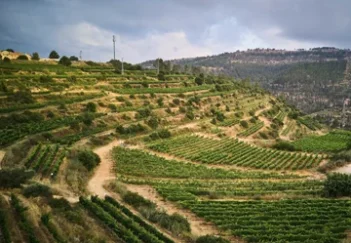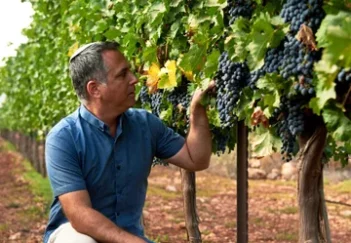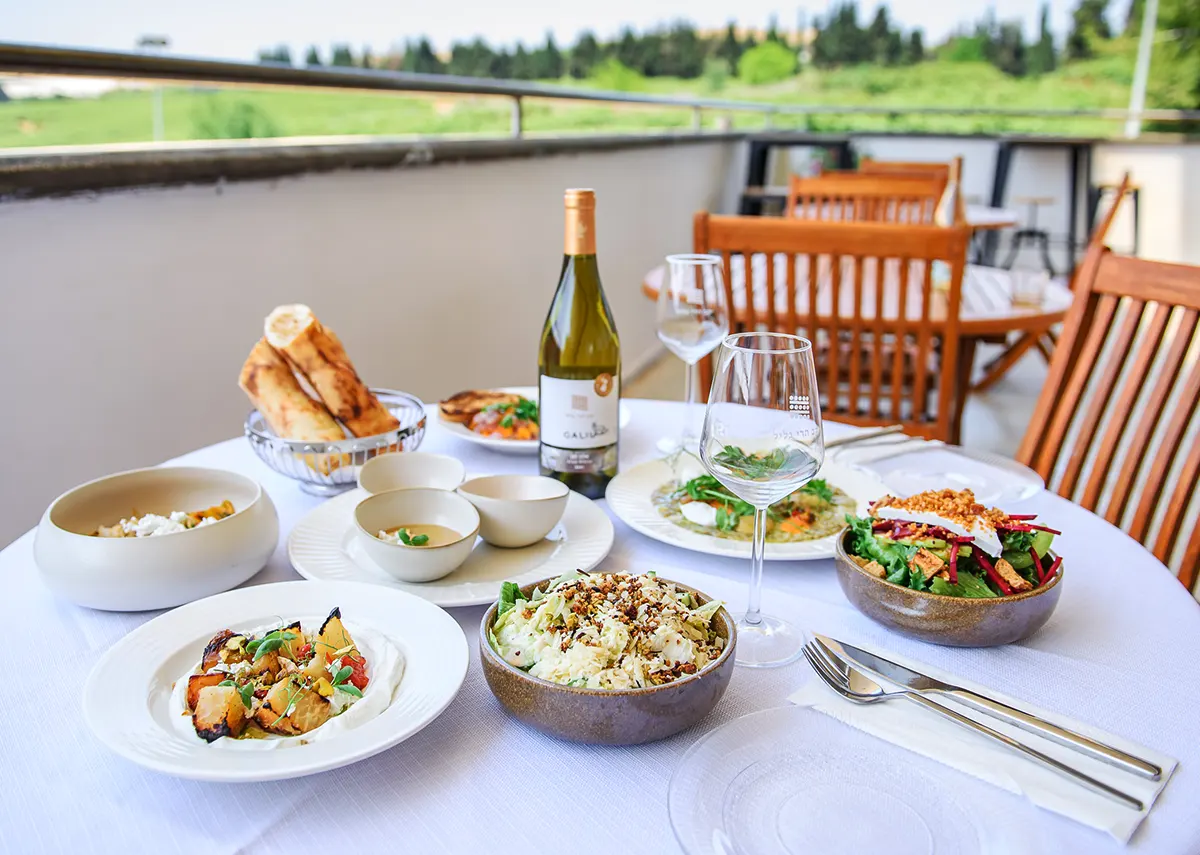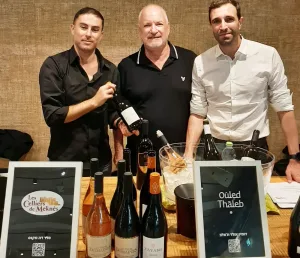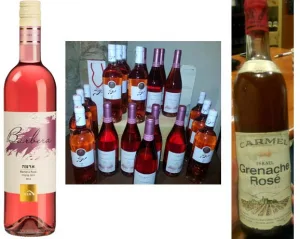Sukkot is the harvest festival, where we sit in booths under the stars. It is also known as the Feast of Tabernacles. However most of the grains, including wheat and barley, and many of the fruits, were harvested well before and are covered by festivals earlier in the year (such as Passover and Shavuot).
What has just been completed by the time Sukkot comes around, is the Batzir, or wine grape harvest. It is a time to gather and celebrate completion of a successful harvest. Furthermore, Chol Hamoed, the intermediate days of Sukkot, is the perfect time to visit wineries. Indeed, I see Sukkot as the Wine Tourism Festival. It is possible to view Israel in a new way, through the prism of its wineries, vineyards and wines. There are so many opportunities presented by the different wine regions. These include the Golan Heights, Galilee, Coastal Plain, Judea, Central Mountains and the Negev.

The Golan Heights in the north east of the country, bordering Syria, is a volcanic plateau that rises to 1,200 meters above sea level. It is overlooked by the snow covered Mount Hermon, and in turn overlooks the beautiful Sea of Galilee. This was where the Israel wine revolution began with the pioneering Golan Heights Winery. Situated at Katzrin, in the central Golan, any visit should include a stop here. They give an excellent tour and explanation. Their Yarden and Gamla Cabernet Sauvignons are icon Cabs at different price points. Other wineries to build up a day tour may include Pelter Winery, where there are local artisan cheeses and a craft distillery as well as wine (kosher & non-kosher.) It is situated at Ein Zivan. After, you may wish to travel north to Mount Odem Winery, which is Israel’s northernmost, highest elevation winery. They have some interesting, quality wines. A good place to stay is the Kedem Wine Village at Kidmat Zvi, where they have extremely high quality cabins, a spa and a family café-restaurant with homemade food. They also own the Assaf Winery, where you can find wines made from Chenin Blanc and Pinotage. The best way to see the Golan, is by going on a jeep tour. This is the way to really get a feel of the terroir.
The Galilee is the region that takes in the north of Israel, bordering on Lebanon. The Upper Galilee is the Tuscany of Israel. It is our most beautiful wine region, with mountains, plunging valleys, stony ridges, running streams and thick forests. The largest concentration of wineries, are in the Eastern Upper Galilee, not far from Mount Meron. Galil Mountain at Kibbutz Yiron, is our most impressive winery practicing sustainability both in vineyard, winery, offices and community. They offer ‘farm to table’ produce if you stop for a brunch. Their prestige Yiron is one of the best value prestige wines in Israel. The Dalton Industrial offers a few winery alternatives. You can visit here and kill a few birds with one stone. Dalton Winery was the pioneering winery of the Galilee. Look out for the Asufa collection with their colorful labels. Recanati Winery will shortly be opening a visitors’ center at their new winery. Another one of interest may be Adir Winery, which combines a winery and dairy.
If you are more in the Western Upper Galilee, there are fewer wineries, but some good ones to visit. These include Stern Winery at Kibbutz Tuval (the Cabernet Franc is excellent) and the unique Kishor Winery at Kishorit. The last named is a village for adults with special needs, which includes the estate winery, bakery and artisan goats’ cheese. I like their refreshing GSM entry level wine.
The Lower Galilee I combine with the Jezreel Valley. Together they can make a reasonable wine route. A visit to Tabor Winery in Kfar Tabor, with an explanation of their ecological vineyards is a must. They have one of the best Sauvignon Blancs in the country. The Jezreel Valley Winery at Hannaton are specialists in Argaman, the main Israeli variety, and Carignan, Israel’s adopted variety. This mini tour can begin or end at Tulip Winery, Kfar Tikva – ‘the Village of Hope’, in Kiryat Tivon. This is one of our brightest wineries, which is also caters for adults with special needs. They have an excellent Sauvignon Blanc and Syrah, and innovative wines like White Tulip, White Franc and Franc Merlot. Well worth a visit. The story will warm your heart.
The Northern Coastal Plain is the most traditional region, being where Baron Edmond de Rothschild founded an Israeli wine industry at the end of the 19th century. It includes the winery towns of Binyamina and Zichron Ya’acov. This region is easily accessible from the center of the country. Furthermore, all the wineries are reasonably close together. The Zichron region, based in the valleys of the southern slopes of Mount Carmel, includes wineries founded in the 1880s (Carmel), 1950s (Binyamina), 1980s (Tishbi), and 2000s (Amphorae) and 2010s (Bat Shlomo). Carmel is the historic winery of Israel and their Zichron Ya’acov Wine Cellars (est. 1892) is the oldest existing winery building, still in use. Here you will see the deep underground cellars built by Rothschild. Tishbi is a winery owned by a family of growers. They have a restaurant, bakery and they offer innovative chocolate and wine tastings. This is the destination for foodies. Amphorae is one of Israel’s most beautiful wineries set in the natural forest area of Kerem Maharal. Here is the place to enjoy a picnic basket and bottle of wine. Finally, Bat Shlomo Vineyards, in the main street of the village of the same name, has a very high quality, prestigious boutique hotel. Here one can combine food, wine and accommodation along with hearing the Rothschild story. On the way north, it is worth stopping off at Kfar Vitkin to see Vitkin Winery. This is the family winery that was the pioneer of ABC winemaking (Anything But Cabernet/ Chardonnay.) Their Carignan, Petite Sirah and Grenache Blanc are outstanding. If you want less wine and more nature, visit the Ramat Hanadiv Nature Park and Gardens. They overlook the Mediterranean Sea on one side, and the Hanadiv Valley vineyards on the other. This beautiful area was established in honor of Baron Edmond de Rothschild. His Mausoleum is on site, if you want to pay your respects.
The Southern Coastal Plain, south east of Tel Aviv, are less about wine today. Real estate proved more profitable than growing vines. However there are good wineries with individuality and character, like Neve Yarak (Neve Yarak, near Hod Hasharon), Benhaim (Neve Yamin, near Kfar Saba), Ghito (Hod Hasharon), Afek (Rosh Haayin), Gros (Nehalim, near Ganei Tikvah) and Lewinsohn (Petach Tikvah), which are easily accessible from Tel Aviv. Apart from wineries, a visit to the Haaretz Museum in Tel Aviv is worthwhile for the wine buff. They have examples of wine presses from different eras, and an exhibition of the life and times of Baron Edmond de Rothschild. In Tel Aviv, there are often interesting tastings. It is worth checking out what is going on at Seren DPT, the wine venue near the Old Clock Tower in Jaffa.
The region of Judea fills the gap between Tel Aviv and Jerusalem. This comprises the gently, rolling hills of the Judean Foothills. These rise quite steeply after Beit Shemesh to the Judean Hills, which start at a 400 meter elevation. This was the first wine region to market itself and to create a wine route. In the Judean Foothills, I recommend a visit to Hulda to visit Barkan Winery. It is Israel’s largest winery situated alongside Israel’s largest vineyards. From here, I like the Beta range from Barkan and the Whole Cluster wines from the Segal brand. Domaine de Latroun is an interesting place to visit, at the Latroun Monastery. An historic winery, with its own vineyards set in the grounds of the monastery. Their Syrah and Pinot Gris are their best wines in my opinion. Bravdo at Karmei Yosef is a rare genuine estate winery with a great story. It was founded by two professors, one of them a very well-known viticulturist. The Kedma Winery makes wine in Qvevri, large earthenware vessels, more commonly known in Georgia. Then there is Clos de Gat, one of our leading small wineries at Harel. Their Syrah and Merlot are their wines I would look out for. They have an ancient wine press in the vineyard.
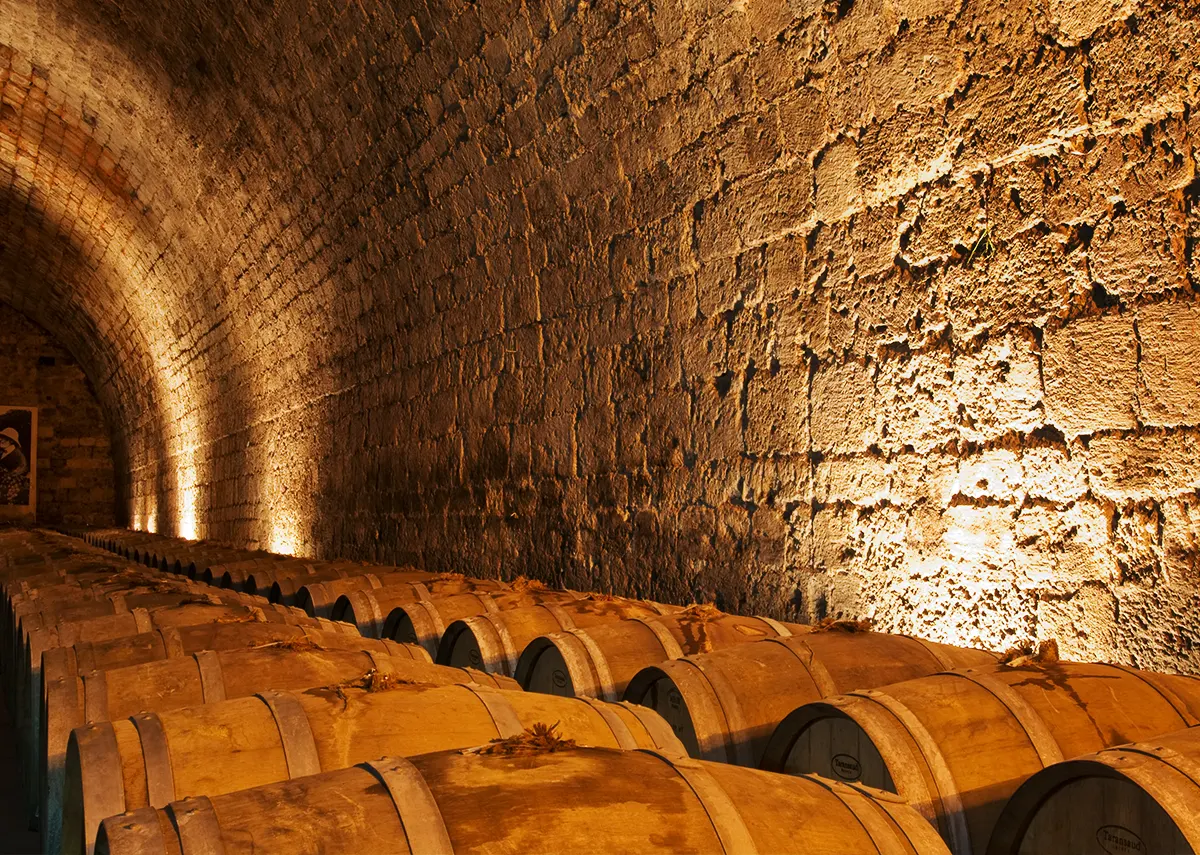
The Judean Hills region offers no end of opportunities for the serious wine lover. Castel, Flam and Tzora are three of Israel’s finest, not so far from one another. Castel (Yad Shmona) is one of the most beautiful and advanced wineries in Israel, with a stunningly impressive barrel cellar. Their Castel Grand Vin and C Blanc du Castel are Israeli classics. Flam (Eshtaol) offers local cheeses and wine. It is the perfect place to enjoy an Eastern Mediterranean/ Levantine experience on their patio overlooking the vines and forest. The Flam Noble and Flam Classico offer quality and value at both ends of the price spectrum. Tzora Vineyards is a place for a tutored tasting, but if you can get on a tour of their Shoresh Vineyard, you will find it fascinating. One of the most interesting wineries these days is Agur Winery with innovative, creative winemakers and Mony Winery offers a panoramic view over their Sorek Valley vineyards and olive groves under a vine pergola. This is an Israeli Arab family, making Kosher wine at a monastery! Here the olive oil is both a best buy …..and a must buy!
The Central Mountains (aka Judea & Samaria or the West Bank) is Biblical Israel, mountainous, sparse with stony, shallow soils. This wine route is at the same time, the youngest and oldest in Israel. Its wineries have only been founded in the last twenty years or so, but this was the heart of Israelite winemaking over 2,000 years ago. South of Jerusalem, I recommend Gush Etzion Winery which has a restaurant, and in the far south of the Central Mountains, Drimia Winery at Susya. They are underrated, producing authentic and quality wines from an 800 meter elevation vineyard. North of Jerusalem, I recommend Psagot Winery, certainly on the short list of Israel’s most beautiful winery. Shiloh Winery, a modern award winning winery, in a place of immense historical significance to the Jewish people where the ancient and modern may be seen together. Finally, at Tura Winery, you will always receive a warm welcome. My favorites from these are the Gush Etzion Sauvignon Blanc, Drimia Sfar, Psagot Peak, a Med blend, Shiloh Cabernet Sauvignon and Tura Merlot.

This leaves the Negev, which is the largest wine region in area, but the smallest in vineyards. This is the south of the country and in fact the desert makes up over 50% of the country. The main wineries here are set far apart. Here the key is to select a winery, and check the surrounding agri-tourism opportunities nearby. Yatir Winery and Midbar are in the north eastern Negev near Arad on the way to the Dead Sea. Ramat Negev Winery is at Kadesh Barnes in the western Negev on the border with Egypt. Nana Vineyards are at Mitzpe Ramon, near the crater of the same name. Newest is the Pinto Winery in Yeroham in the Central Negev. Not far away is the Carmey Avdat Winery which offers wine, accommodation, ancient terraces and evidence of winemaking in ancient times. It is certainly worth visiting Shivta and Avdat to understand better the scale of the wine industry during the period of the Nabateans and then the Byzantines. Remember there are wineries everywhere…even in Eilat!
For a guide, check out the internet. Look at the books ‘The Wine Route of Israel’ (2015) and ‘Wines of Israel’ (2020) – both published by Cordinata, and ‘Wine Journey – An Israeli Adventure’ (2021), which will help plan your trip. Wineries are listed in regions, with maps. Never assume the winery is ready, open and available for the casual tourist. Always check and book in advance to avoid disappointment. The Kosher tourist should know that not all wineries observe Kashrut, and the non-religious tourist should be aware that many wineries are closed on Shabbat (Saturdays) and holidays.
Note wherever you go, there are ethnic and Israeli restaurants of every type at every price points, showing the quality and vitality of the Israeli culinary scene. In short, it is booming. Tel Aviv has become a special visit destination for gourmets and gourmands, but gems may be found wherever you are.
Also in every region, there are small home bakeries, boutique olive oil presses, artisan cheese dairies, craft breweries and distilleries, and beehives producing local honey. These can be sought out to pad out a gourmet tour, if one winery a day is enough.
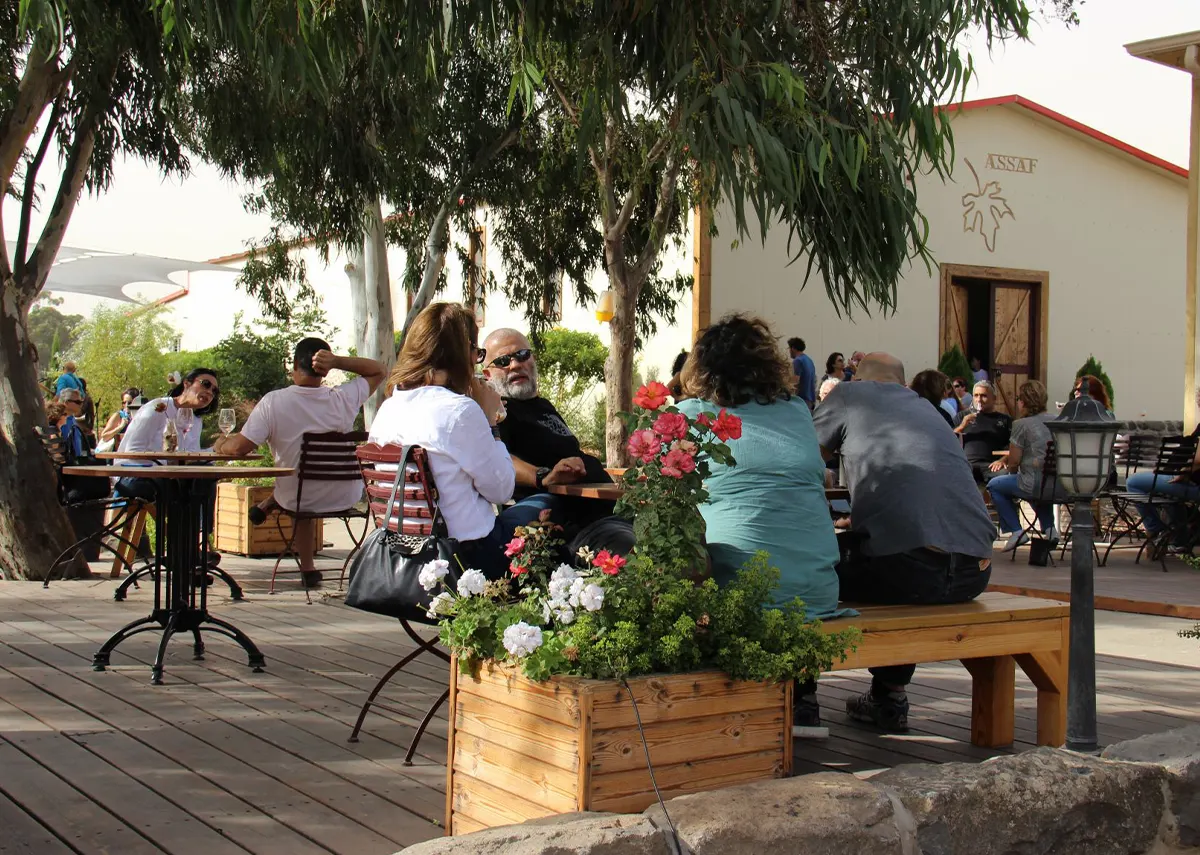
It is wise not to fill in every minute of the day with activities. There should be toilet breaks, time to eat, time to shop…..remember everything takes longer than planned. I would suggest a maximum of three wineries a day is enough. Finally, it is recommended to spit if you are doing wine tastings. There will be spittoons provided, if not, you may request for them to be provided. Don’t taste on an empty stomach and be sure always to drink a great deal of water. Most important, have fun!
The writer is a wine industry insider turned wine writer, who has advanced Israeli wines for 35 years. He is referred to as the English voice of Israeli wine and is the wine writer for the Jerusalem Post. www.adammontefiore.com
Photos: Kfir Haravi; David Silverman












